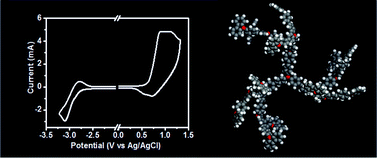Novel dendrimers consisting of a triphenylamine core and 1st to 3rd generations of 9-phenylcarbazole-based dendrons were synthesized by Suzuki coupling reaction through convergent approach. Their structures were confirmed by two-dimensional correlated H–H COSY and C–H HSQC NMR spectra, MALDI-TOF MS and elemental analysis. The dendrimers exhibit excellent thermal stability with 5% weight loss temperatures over 540 °C. The computer modeling reveals that the dendrons in dendrimers greatly twisted with the generation, leading to the dendrimers decreased crystalline ability. Of interest is the observation that, for an identical dendrimer, the solid film displays the similar UV absorption and luminescence emission profiles to the solution sample, indicating that, after evaporation of solvent, the rigid dendrimer can well maintain its conformational morphology and the aggregation or stacking of the chromophoric groups is significantly inhibited. All the dendrimers can emit intense fluorescence with narrow full width at half maximum (FWHM) around 46–50 nm. Moreover, with the incremental generation, the quantum efficiencies remarkably increase from 64 to 95%, suggesting that the highly contorted and bulky dendrons effectively decrease energy wastage and non-radiative decay. The synergistic effect of electron-donating triphenylamine core and 9-phenylcarbazole-based dendrons results in the HOMO energy level of −5.36 eV for the 3rd-generation dendrimer, very close to the work function of the ITO/PEDOT electrode (−5.2 eV), which characteristic is very advantageous for the hole injection and transport materials.

You have access to this article
 Please wait while we load your content...
Something went wrong. Try again?
Please wait while we load your content...
Something went wrong. Try again?


 Please wait while we load your content...
Please wait while we load your content...